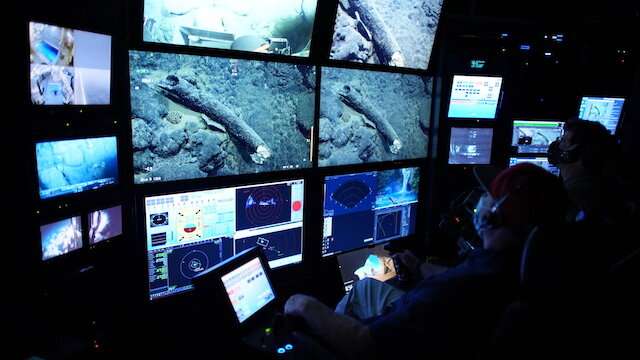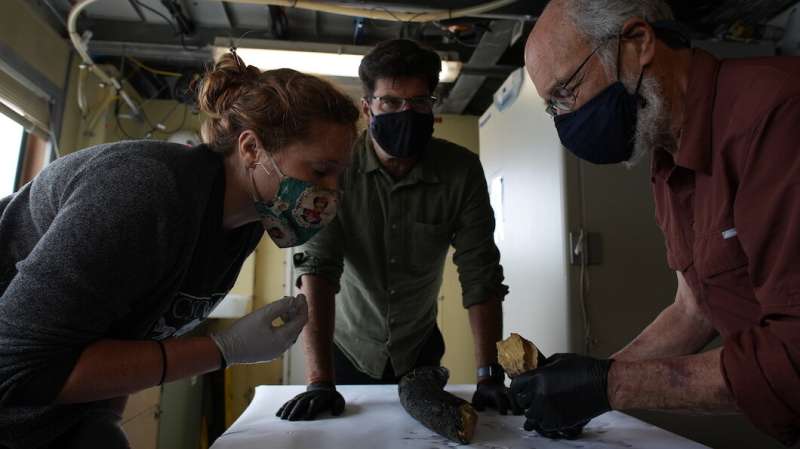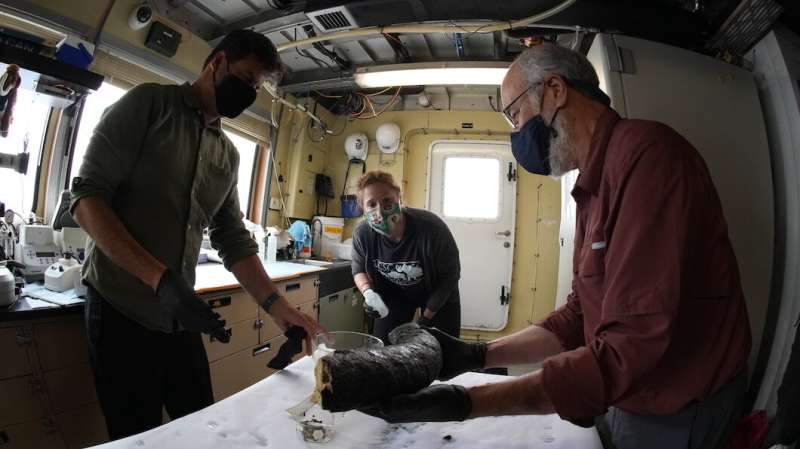NUKE NEWS
Puerto Rico study and advanced reactors receive US funding
24 November 2021
The US Department of Energy (DOE) has awarded funding to the Nuclear Alternative Project (NAP) to study the potential siting of small reactors in Puerto Rico. Funding also goes to address hurdles to the use of small reactors in commercial shipping and to support the development of advanced reactor designs.
.jpg?ext=.jpg) Angel Reyes, Ramon Martinez, Jesus Nunez and Valerie Lugo of the Nuclear Alternative Project (Image: NAP)
Angel Reyes, Ramon Martinez, Jesus Nunez and Valerie Lugo of the Nuclear Alternative Project (Image: NAP)
A total of USD8.5 million was awarded on 18 November to five industry-led projects through the through the Office of Nuclear Energy's US Industry Opportunities for Advanced Nuclear Technology Development funding opportunity. This funding is intended to "help commercialise promising advanced nuclear technologies," said the DOE.
"Advanced reactors will completely change the way we engineer, build, and operate nuclear reactors," said Principal Deputy Assistant Secretary for Nuclear Energy Katy Huff. "These awards support technical and regulatory strides necessary for commercialising new carbon-free nuclear technologies poised to help our nation reach net-zero emissions by 2050."
The headline award of USD1.6 million was for a "phase 2 site suitability study" regarding small reactors and microreactors in Puerto Rico. The money will go to NAP, which has identified two potential sites on the island, based on Nuclear Regulatory Commission criteria. A previous study by NAP has found small reactors and microreactors would be feasible to complement Puerto Rico's increasingly solar-dominated grid, while increasing resilience and lowering power prices for its manufacturing economy.
NAP said the news was "exciting" for the company, noting that the work will be undertaken by Puerto Rican nuclear experts. DOE said the results would help it to commercialise the technologies for island and remote locations in general.
Another award worth USD800,00 was made to the American Bureau of Shipping to "address hurdles in the maritime domain so that new reactor technology can be rapidly deployed for commercial applications."
Two awards were made to advanced reactor technology companies. The US subsidiary of Terrestrial Energy will receive USD3 million to develop an approach to handling uncertainty in the modelling of off-gas systems for molten salt reactors such as its IMSR. Terrestrial Energy CEO Simon Irish said: "These grant programmes support private companies as they work to deliver nuclear power technologies that can succeed in competitive global energy markets and deliver global net-zero goals. Technologies such as our IMSR Generation IV nuclear plants will produce reliable, cost-competitive heat and power without emissions, making them uniquely capable of competing with fossil fuels."
Lastly, General Atomics' Electromagnetic Systems subsidiary will receive USD 2.7 million from the DOE to deliver a physics-based model for its silicon carbide-based fuel for high-temperature reactors.
Holtec and Hyundai finalise SMR design and deployment agreement
24 November 2021
Holtec International has finalised an agreement with Hyundai Engineering & Construction of South Korea for the turnkey supply of Holtec's SMR-160 small modular reactor (SMR) plant worldwide. Holtec is considering deploying the first SMR-160 at Oyster Creek in New Jersey, where it is currently in the process of decommissioning a former boiling water reactor.
.jpg?ext=.jpg) The signing ceremony (Image: Holtec)
The signing ceremony (Image: Holtec)
Hyundai Engineering & Construction will perform the detailed design of the balance of plant and prepare the full plant construction specification for the SMR-160, which Holtec has been developing since 2010, US-based Holtec said on 22 November. The partnership also provides for project delivery rights for Hyundai, subject to certain provisions. "This agreement is global in scope with provisions to comply with the preference of the customer, effect the most competitive project cost, and in accord with Holtec's existing commitment with Kiewit for the North American market," the company said.
Holtec will serve as the overall architect engineer for the plant and provide the major nuclear components through its US manufacturing facilities and international supply chain, and will provide the instrumentation and control systems through its partnership with Mitsubishi Electric Corporation. Framatome is the selected fuel vendor for SMR-160.
The cooperation with Hyundai combines Holtec's expertise in design, engineering, manufacturing, and project delivery of nuclear components with Hyundai’s EPC and construction management capabilities for major projects, Holtec said. The framework of the agreement and worldwide collaboration will support standardisation of the SMR-160 design, it added.
"The partnership with Hyundai Engineering & Construction enhances our ability to deliver SMR-160 projects on schedule and at a competitive price," Holtec Senior Vice President of International Projects Rick Springman said.
The SMR-160 is a pressurised light-water reactor, generating 160 MWe (525 MWt) using low-enriched uranium fuel, with flexibility to produce process heat for industrial applications and hydrogen production. The design has completed the first phase of the Canadian Nuclear Safety Commission's three-phase pre-licensing vendor design review, and is undergoing pre-licensing activities with the US Nuclear Regulatory Commission.
Holtec said it aims to secure a US construction licence in 2025, and is "actively exploring the possibility" of deploying an SMR-160 at Oyster Creek - which it acquired from Exelon in 2019 following the plant's closure the previous year - and at two other sites in the southern USA.
Contract for Romanian lead-cooled reactor research facility
23 November 2021
A consortium including Italy's Ansaldo Nucleare and Romania's Reinvent Energy has been awarded a contract worth about EUR20.0 million (USD22.5 million) for the design, procurement, installation and commissioning of a research facility for the development of lead-cooled reactors. The Advanced Thermo-Hydraulics Experiment for Nuclear Application (ATHENA) facility will be built at the RATEN-ICN research centre near Pitesti in southern Romania.
.jpg?ext=.jpg) The RATEN-ICN facility facility in Mioveni, near Pitesti, Romania (Image: RATEN-ICN)
The RATEN-ICN facility facility in Mioveni, near Pitesti, Romania (Image: RATEN-ICN)
ATHENA will be a 2.21 MWt pool-type facility housing 880 tonnes of liquid lead in a main vessel, measuring 3 metres in diameter by 10 metres in height. It will accommodate scale components for testing and demonstration of lead fast reactor (LFR) technology.
The Ansaldo Nucleare and Reinvent Energy consortium will be supported by Italy's National Agency for New Technologies, Energy & the Environment (ENEA) and SRS Servizi di Ricerche e Sviluppo srl for the conceptual and executive design of the technological part. It will also be supported by Romania's Institute for Studies & Power Engineering and Somet for the design of civil works and installation activities, respectively.
The project - to be carried out over about two years - involves the construction of an electrical core-based simulator, a main pump and a heat exchanger similar to the arrangement of the Advanced Lead-cooled Fast Reactor European Demonstrator (ALFRED) system.
The facility will also be equipped with a water-cooling circuit to ensure representative conditions on the secondary side of the heat exchanger. The main scientific objectives of ATHENA concern the research and development needs (e.g. chemistry control, lead/water interaction), as well as stationary and transient testing of thermohydraulic phenomena occurring during normal operation and accidental conditions of an LFR reactor.
"The ATHENA project will bring to light the largest facility in Europe for research on LFR technology," said Ansaldo Nucleare CEO Luca Manuelli. "The experimental results produced will be key to supporting the development of ALFRED in Romania and in Europe. In line with our NewClear vision, the collaboration between research centres and key industrial players will bridge the gap for faster deployment of advanced nuclear technologies with small modular reactor characteristics, towards a cleaner, safer, and more sustainable role of nuclear in the European energy transition."
Catalin Ducu, general manager of RATEN-ICN, added: "ATHENA is the first step in a complex technological infrastructure through which the physics and engineering of the next generation of lead-cooled nuclear power plants will be better understood and validated. ATHENA is a first milestone in the ambitious ALFRED infrastructure project and represents a great opportunity for the South-Muntenia region for the development of highly-qualified Romanian professionals, as well as for the European research and development programme."
"The Romanian industry is deeply involved in this important project, so we are honoured to have this significant contribution," said Marius Gheorghiu, general manager of Reinvent Energy. "Together with our partners, we believe in a healthy green future, built with sustainability, quality and innovation."
A 300 MWt demonstration ALFRED unit is being built at ICN's facility in Mioveni, near Pitesti, where a fuel manufacturing plant is in operation for the country's two operating Candu reactors. ALFRED is seen as a prelude to an industrial demonstration unit of about 300-400 MWe. The lead-cooled reactor will employ mixed-oxide fuel and will operate at temperatures of around 550°C. It features passive safety systems. The total cost of the project is put at some EUR1.0 billion (USD1.1 billion).
The conceptual design of the ALFRED reactor and the integrated project were led by Ansaldo Nucleare under the seventh Euratom framework programme. ENEA performed the core design, technological development and safety analyses through numerical and experimental approaches.
The reactor is being developed through the European Sustainable Nuclear Industrial Initiative (ESNII), which brings together industry and research partners in the development of so-called Generation IV Fast Neutron Reactor technology, as part of the EU's Strategic Energy Technology Plan. ESNII was set up under the umbrella of the Sustainable Nuclear Energy Technology Platform, formed in 2007 and bringing together more than 90 stakeholders involved in nuclear fission.
Components headed to Akkuyu
23 November 2021
Russian manufacturers are dispatching several components to Turkey's first nuclear power plant, Akkuyu, which is currently the largest nuclear construction site in the world with 13,000 people working on a daily basis on the site that will house four large reactors.
.jpg?ext=.jpg) Akkuyu 2's reactor pressure vessel in transit (Image: OMZ Group)
Akkuyu 2's reactor pressure vessel in transit (Image: OMZ Group)
The first reactor at Akkuyu began construction in April 2018 and is scheduled to start up in 2023. It has already had major components for its reactor and primary coolant circuit installed.
Last week, Rosatom's main manufacturing subsidiary Atomenergomash announced it had made most of the components for one of Akkuyu 1's passive safety systems, the so-called SPZAZ tanks. These large metal tanks are installed above the reactor and steam generators. If the pressure in the reactor coolant system drops below a certain level, a solution of boric acid held in the SPZAZ tanks would flow automatically into the reactor core. Boric acid cuts reactivity and therefore heat generation in the reactor core by absorbing neutrons. The tanks are made to hold 120 cubic metres of boric acid solution each.
Atomenergomash said it has made seven of the eight SPZAZ tanks for Akkuyu 1, and the final one will be complete in time for shipment in December.
Akkuyu 2 is about one year behind unit 1 and should soon receive its reactor pressure vessel and main circulation pump. Its steam generators were shipped in August.
The reactor pressure vessel is thought of as the heart of the power system, housing the fuel assemblies and reactor internals, as well as being the central part of the water coolant and steam production system. The vessel for Akkuyu 2 has now begun its journey to the site, according to its manufacturer OMZ Group, which undertook the work for Atomenergomash at its Izhora plant.
OMZ said the cylindrical vessel is 12 metres long and 4.5 metres wide and made of steel some 20 centimetres thick. It weighs 334 tonnes. It was dispatched from Izhora on a barge to Saint Petersburg where it will be loaded on a ship for transport to Akkuyu, on Turkey's Mediterranean coast.
Meanwhile, at Atomenergomash's Petrozavodsk plant, the main circulation pump for Akkuyu 2 was assembled and checked. This component ensures the circulation of coolant through the reactor vessel and steam generators and therefore has an important safety role. Built to operate at temperatures of 300°C and withstand pressures of 16 MPa, the roughly spherical pump is 3.5 metres in diameter and weighs 48 tonnes when fully assembled. It will be given protective coatings and painted before shipment.
Manufacturing of Akkuyu 3's reactor pressure vessel continues at Atomenergomash's Volgodonsk plant.
Akkuyu is being built by Russia's state nuclear company Rosatom. The company's internal magazine, Strana Rosatom, said it is the world's largest nuclear construction site, with 13,000 people working on a daily basis towards four large reactors. Units 1, 2 and 3 are officially under construction, while unit 4 is at a preparatory stage and received authorisation to pour first concrete in October
NRC 'indicates acceptance' of Kairos safety evaluation
23 November 2021
The US Nuclear Regulatory Commission (NRC) has issued a draft safety evaluation report indicating its initial acceptance of Kairos Power's source term methodology for its Kairos Power fluoride salt-cooled high temperature reactor (KP-FHR). The topical report, which Kairos submitted to the regulator in June 2020, is the first of its kind to be reviewed by the NRC.
.jpg?ext=.jpg) How the KP-FHR plant could look (Image: Kairos Power)
How the KP-FHR plant could look (Image: Kairos Power)
The report, which outlines the company's approach to calculating the amount of radioactive material that could be released to the environment during an accident, was developed through a cost-shared award from the US Department of Energy (DOE). If approved, a final safety evaluation report could be issued by February 2022 and could be used throughout the licensing process, reducing risks associated with the licensing and deployment of the reactor.
The KP-HFR uses TRISO - TRI-structural ISOtropic - fuel, first developed by DOE in the 1960s. Research by Idaho National Laboratory has indicated that the source term for TRISO-based fuel is significantly less than for traditional fuels, DOE said, adding that this "further reinforces the enhanced safety and operation of Kairos's reactor design as it continues with the pre-licensing phase of the NRC process".
"This accomplishment strengthens our team's extensive pre-application engagement with the NRC and builds licensing certainty for our advanced reactor technology," Kairos Power CEO Mike Laufer said. "In combination with our iterative hardware demonstrations, our licensing engagement contributes to the cost certainty that will be necessary for commercial demonstration and deployment."
Kairos on 29 September filed the first portion of an application for a construction permit to build the 35 MWe Hermes molten salt test reactor at a site in Oak Ridge, Tennessee. This has now been made available for public comment by the NRC.
Hinkley Point C cleaner than renewables, study shows
22 November 2021
Carbon dioxide emissions from the electricity generated by the UK's newest nuclear power plants will be even lower than wind and solar power, a new analysis has confirmed. A detailed and independently verified study into lifetime emissions from Hinkley Point C (HPC) was carried out for EDF by environmental specialists Ricardo Energy & Environment and verified by engineering consultants WSP.
-2016.jpg?ext=.jpg) How the completed Hinkley Point C plant should appear (Image: EDF Energy)
How the completed Hinkley Point C plant should appear (Image: EDF Energy)
EDF said it commissioned the report "to communicate the potential life cycle environmental impacts associated with the construction, operation, and decommission of the future HPC nuclear power plant, in terms of electricity output generated and then delivered to a downstream user." The study, it said, "follows internationally agreed standards and is thought to be one of the most detailed ever undertaken for a nuclear power station."
The company said it wanted to prepare a lifecycle carbon assessment (LCA) for HPC over its life, "aligned as closely as possible to the relevant product category rules (PCR), and to communicate these results publicly." PCRs set out the category-specific requirements for conducting LCAs and reporting results in environmental product declarations to internationally recognised standards.
EDF commissioned Ricardo to undertake an LCA in accordance with PCR 2007:08 Electricity, steam and hot/cold water generation and distribution - also known as the Electricity PCR - as much as possible, using the best available data from sources such as the Development Consent Order submission and data recorded during construction so far. This work assesses HPC's impacts across its life cycle, considering: the activities 'upstream' of generation, such as the procurement of raw materials and fuel fabrication; the 'core' activities associated with constructing, operating and decommissioning HPC; and the 'downstream' activities associated with distributing electricity to customers.
The study - titled Life Cycle Carbon and Environmental Impact Analysis of Electricity from Hinkley Point C Nuclear Power Plant Development - shows the global warming potential associated with generating 1kWh of net electricity at HPC as 5.49 grams of CO2 equivalent, whilst that associated with a downstream user receiving 1kWh of electricity generated by HPC has been calculated as 10.91g CO2 equivalent once the impacts of the transmission and distribution networks are taken into account.
By comparison, the Intergovernmental Panel on Climate Change's median estimate for offshore wind is around 12g CO2 equivalent per kWh and 48g CO2 equivalent per kWh for large-scale solar energy. All are drastically lower than coal at 820g CO2 equivalent per kWh and gas at 490g CO2 equivalent per kWh.
Hinkley Point C, construction of which began in December 2018, is composed of two EPR reactors of 1630 MWe each and Sizewell C is proposed to be an exact copy from the ground up, EDF Energy has said. Sizewell C has planning permission and awaits a final approval from the UK government.
"This detailed study confirms the low-carbon credentials of new nuclear at Hinkley Point and Sizewell," said Humphrey Cadoux-Hudson, managing director for Sizewell C. "By replacing fossil fuel power with low-carbon electricity which doesn't depend on the weather, Hinkley Point C and Sizewell C will support the expansion of renewables in the UK and make a big contribution to lowering emissions to net-zero."
UN report supports findings
The findings of the EDF study are in line with those of a report published recently by the United Nations Economic Commission for Europe (UNECE). That report confirms that nuclear technology as a whole has the lowest lifecycle carbon intensity of any electricity source, ranging from 5.1-6.4g CO2 per kWh.
The UNECE report also found nuclear has the lowest lifecycle land use, as well as the lowest lifecycle mineral and metal requirements of all the clean technologies.
"Here we have a detailed, scientific assessment confirming nuclear as a green and sustainable technology, that uses less carbon, less land, and less material than any other," said Tom Greatrex, Chief Executive of the Nuclear Industry Association. "If we are serious about cutting emissions and meeting net-zero targets, we must act on the science and build new nuclear alongside other low-carbon sources of energy."
Researched and written by World Nuclear News





 A page of the Einstein-Besso manuscript is displayed at Christie's in Paris. Photograph: Chesnot/Getty Images
A page of the Einstein-Besso manuscript is displayed at Christie's in Paris. Photograph: Chesnot/Getty Images




